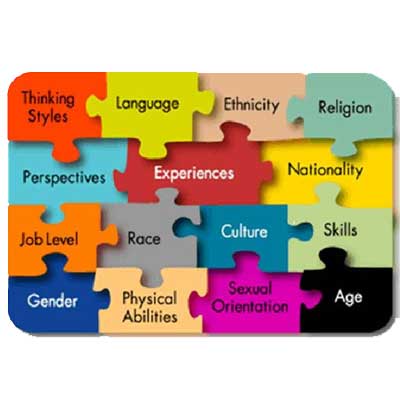Workplace Diversity – Need Of The Hour | Aparna Sharma | Consulting Editor | The People Management
 Workplaces nowadays have started to embrace Diversity and Inclusion (D&I) programs to enhance company culture. While many people think diversity is only related to gender, race, and culture, it goes way beyond including disability and socioeconomic status. Today, the prime discussion is about- the types of diversity in the workplace and why every organization should adopt inclusivity.
Workplaces nowadays have started to embrace Diversity and Inclusion (D&I) programs to enhance company culture. While many people think diversity is only related to gender, race, and culture, it goes way beyond including disability and socioeconomic status. Today, the prime discussion is about- the types of diversity in the workplace and why every organization should adopt inclusivity.
Workplace diversity has many forms: race and ethnicity, age and generation, gender and gender identity, sexual orientation, religious and spiritual beliefs, disability, and many more.
As a leader or a manager, we must ensure our workforce is diverse and inclusive as it promotes equality, enhances employee engagement, builds positive workplace relationships, and employee job satisfaction.
What is Workplace Diversity?
Workplace Diversity is nothing but a workplace that comprises employees with different characteristics such as sex, gender, race, ethnicity, sexuality, etc.
An organization that prioritizes diversity will have a workforce that consists of people from different backgrounds and sections of society. It is also a place where everyone is treated equally in spite of everyone’s differences.

Types of Diversity
According to the standard definition of Diversity, the forms of diversity in a social construct are theoretically infinite. It encompasses every characteristic that appears with variations amidst a group of people. But, generally, when it comes to workplaces, there are 7 primary types of diversity we can see:
1. Race and Ethnicity
Race and ethnicity are crucial factors when we refer to diversity in the workplace, considering the long, controversial, and complicated history of race in the United States and the rest of the world. Often race and ethnicity are interchangeable, but they are different.
Race is a person’s biological identity, including physical characteristics such as skin color, hair type, etc. One’s race might affect factors like life expectancy and treatment by the criminal justice system. While on the other hand, ethnicity is more about a person’s cultural background. It encompasses multiple racial or ethnic identities. More than biology, it is about cultural or geographic history.
People who belong to diverse racial and ethnic groups bring in unique perspectives to the workplace. McKinsey’s recent study shows that organizations with higher racial and ethnic diversity are 35 percent more likely to have stronger financial returns.
2. Age and Generation
For instance, age is generally categorized by generations- baby boomers, Generation X, Y, and Z, and Millennials. It is evident that people of the same age group don’t usually think the same way, yet a person’s age does bring in some similarities.
For example, Generation Z, born after 1995, haven’t seen a world without mobile phones or the internet. This makes a difference in the way they think compared to people from the 1970s.
Knowingly or unknowingly, companies often engage in age bias. For instance, when you recruit only from university campuses, it exempts older workers who may also be entry-level employees. On the contrary, many organizations only look for experienced people based on their age, which leaves out young freshers who also have the experience required for the job.
3. Gender and Gender Identity
Half of the country’s population consists of women; therefore, it is essential to have equal representation for them in the workplace. This is one of the most evident types of diversity- having a gender-diverse work culture is not about the number of women and men in the company but equality.
In order to be a truly gender-diverse company, businesses need to address issues like the gender pay gap, where women are routinely paid less for the same jobs as their male counterparts. To be successful, organizations need to look at the barriers faced by both genders when contributing to the workforce and see how they can alleviate some of those restrictions for their employees.
In the U.S, over 1.4 million people identify themselves as transgender. Human resources must use inclusive language in the policies. It is good to refrain from using gender-binary language, as it might hurt people from other genders like gender-neutral, transgender, etc.
4. Sexual Orientation
Sexual orientation or sexuality is about who a person is attracted to. Yes, it is a personal affair, yet employees must feel safe to express their sexuality with their colleagues without facing any discrimination or workplace harassment.
The LGBTQ+ community comprises people from various backgrounds, interests and thus faces many challenges at work. An organization must ensure safety for people belonging to sexual minorities. An egalitarian workplace increases job satisfaction and employee retention.
5. Religious and Spiritual Beliefs
People belong to and follow many religions across the world. Many employees also choose specific religious practices. To promote diversity in the workplace, it is vital to be aware of your company’s unconscious biases regarding religion.
Freedom to follow your religious practices like wearing a rosary, or a hijab, depicts tolerance and equality in the workplace. If your company has designated prayer rooms, religious holidays, and celebrations, it can create a diverse work culture.
6. Disability
Usually, people tend to think that disability is associated only with physical mobility. However, workers might have disabilities that may vary from limitations in vision and movement to learning abilities and mental health issues.
If you want to promote diversity, you must bring in competent people with disabilities who can also show equal productivity just as their colleagues.
Companies must also focus on making the workplace accessible to all by adding elevators and ramps in place of stairs, use telephone headsets and screen readers to facilitate smoother communication etc.
7. Socioeconomic Status and Background
Employees in a company come from different socioeconomic backgrounds and have varying attitudes towards specific factors of life, like money, social status, education, etc. For example, someone who grew up being poor can bring a different perspective than someone who belongs to a wealthy family.
It is imperative to notice if your organization focuses on hiring people from all backgrounds. You must also ensure no employee is judged for their social status. To ensure this, you can hire through newspaper ads too besides online job searches.
Conclusion
It is imperative to understand the importance of diversity in the workplace for every organization. Every company needs to focus on the 7 types of diversity stated above( as applicable) in the workplace; it’s time you implement them if you haven’t already.


